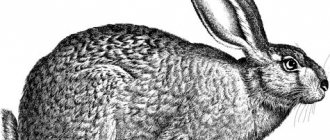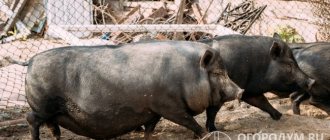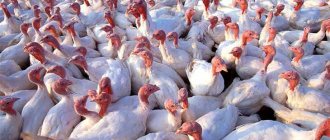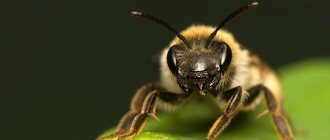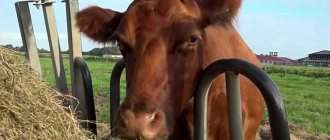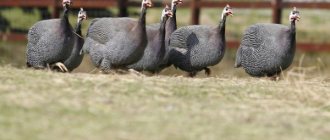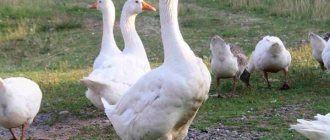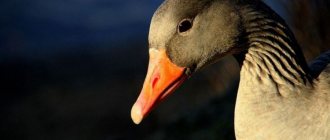- home
- Rabbits
- Breeds
10/21/2018 The German Riesen rabbit breed is popular in Europe. Farmers try to breed them to obtain dietary meat and valuable fur. Today, there are three breeds of giant eared beetles: German Riesen, Butterfly and White Giant. Riesens are the largest breed of rabbits in the world. They can reach 14 kg in weight.
History of the origin of the Risen rabbit breed
The first rabbits appeared in the 16th century in Flanders. These were short-haired animals with dense fur of a rich gray color. Even then, long-eared animals were distinguished by their large size, massive build, and powerful paws. The animals weighed 6 kg or more. Riesen's first name was the Belgian Giant.
In the 19th century, rabbits came to Germany, where their mass breeding and selection began. The Germans emphasized weight gain and meatiness of the breed. In 1937, these pets were officially patented as the "German Riesen" or "German Giant". Since then, they have been actively grown not only in Germany, but are distributed throughout Europe.
Not all breeders recognize the purebred nature of the breed, considering the Rizens to be only a branch of the Flanders rabbits. Disputes over a given topic do not stop.
Behavior
The calm and easy-going nature of German Riesens allows them to be kept as pets. There is one more special feature - the animals are quite clumsy and clumsy.
Thanks to their developed intelligence, these animals are able to interact with humans and find a common language with them. Largely for this reason, some people keep giant rabbits in the absence of an intention to sell meat.
Did you know? The interesting rabbit habit of sleeping with its muzzle constantly in motion is not at all accidental. The fact is that an animal, evolutionarily in the rank of prey, must always be on guard. The quivering tip of the nose, the moving mustache are sensors that analyze the safety of the environment even in sleep. As soon as the situation becomes suspicious, the senses send an alarm signal to the brain, and the animal instantly wakes up.
In America, the giant has become widespread as a pet. But it is not recommended to have such an animal for small children. Giants are massive, overweight and can inadvertently harm babies.
Description and characteristics of the breed
The Risen rabbit is a representative of the meat breed, which stands out for its large dimensions and massive physique. These pets are clumsy and clumsy, so it is better to keep them in spacious cages.
Rabbits have a kind, easy-going character. They do not conflict with their relatives, get along well with other animals in the barnyard, and do not fight for territory. Rizens make contact with people without fear, are trained, remember their nickname and the breeder’s simple commands.
Appearance
Rabbits have well-developed muscles. The body is proportional to the head, massive body, wide back and powerful chest. Males have a round muzzle with puffy cheeks, while females have a gracefully elongated muzzle. Rabbits have brown eyes and erect ears that are 13-20 cm long and resemble skittles in appearance.
Most of the rabbits' muscles are located in the lower part of the body, but the front legs are also massive for balance. The length of the body is 65-80 cm, the weight of adults is 10 kg, but there are cases when Rizens grew to 15 kg or more.
Coarse short hair up to 5 cm long. There are representatives of the breed with different fur colors - from blue to dark gray, red shades are not excluded. There are no standards for coat color; it is inappropriate to judge purebredness based on this criterion.
Risen agouti color. Male, 5 months old.
Productive qualities
When breeding Risen rabbits, the emphasis is on the meatiness of the breed. The animals have tender, dietary meat with a pleasant taste, which breeders sell. More often, rabbits are bred only for their delicious meat products.
The animal's valuable fur also deserves attention. Unlike small rabbits, Risen skins are large, with an even distribution of fur, and are highly valued in light industry for making clothes and insulation.
Risen's character
Despite the agricultural focus of the breed, the calm, slow and good-natured nature of these animals allows owners to communicate well with them. Often, Risen rabbits migrate from the meat type to the category of pets, the size of which is comparable to the average dog.
By the way, Risen is one of the few breeds that is not particularly shy and calmly interacts with other pets - dogs and cats. They do not show aggression and are able to play with children. They know their nickname well.
Advantages and disadvantages
Before you start breeding Risen rabbits, study the advantages of this breed:
- flexible character;
- high fertility;
- tasty, dietary meat;
- valuable skin;
- maternal instinct of females.
These pets have their drawbacks, which force breeders to think several times about the right choice:
- slow growth;
- clumsiness;
- aesthetics of the breed;
- high feed costs;
- risk of obesity;
- the need for large cages, enclosures;
- capriciousness in conditions of detention;
- risk of morbidity (weak immunity).
How to choose a rabbit
It is recommended to buy Risen rabbits from certified breeding farms. The best age to purchase a German giant is 3-4 months. The strongest rabbits are those from the spring litter.
German giants should be active, moderately well-fed and healthy. In order not to make a mistake with your choice, when purchasing you should pay attention to the following criteria:
- appearance;
- availability of documents;
- behavioral characteristics;
- condition of ears, skin, eyes, teeth and fur.
The Risen rabbit has the correct bite, a sinewy muzzle, strong paws and long erect ears.
On a note. To avoid possible disappointments, at the selection stage it is recommended to immediately screen out rabbits with a flattened muzzle, carious teeth, narrow pelvis, uneven fur, short drooping ears and weak deformed limbs.
Risen rabbits are large animals with thick, dense fur and a phlegmatic temperament. Due to their undemanding living conditions, interesting appearance, calm character and high productivity, German giants are in particular demand among farmers and lovers of unusual pets.
Choosing a good individual
To select healthy and purebred animals, study the breed standards. Otherwise, the value of domestic animals and their products (meat, fur) is significantly reduced. Breeding rabbits are not cheap, and this point is also important to consider when purchasing.
Risen blue. In Holland they call it the Flemish Giant.
Basic Rules
Buy Risen from a breeding farm where the breeder has certificates and there is no doubt about the purebred of the breed. Buying a rabbit at the market promises disappointment, since the animal may not be a purebred, but a half-breed.
Other recommendations when choosing Rizenov:
- Buy rabbits when they are 3-4 months old.
- Choose spring-fed animals.
- Do not purchase adult rabbits for breeding.
- Choose healthy individuals: well-fed, with a straight back and even coat.
- Make sure your animals have a correct bite and healthy teeth.
- Examine the ears: they are erect, without mucus or flaking inside.
When choosing, do not lift the animal by its hind legs or ears. In the first case, a tendon rupture may occur, in the second - severe fright up to cardiac arrest.
Signs of purebredness
Breeding rabbits are much more expensive. In order not to buy a Risen with a marriage or a half-breed, pay attention to the following breed standards:
- clean paws;
- sinewy muzzle;
- smooth coat without bald patches;
- erect ears 13-20 cm long;
- adult weight from 8 kg;
- clean ears;
- correct bite;
- absence of caries on teeth;
- a good appetite.
If there is a deviation in 1-3 signs, it is better to refrain from making an expensive purchase. Perhaps the rabbit is purebred, but it is unlikely to reproduce healthy offspring.
Red Risen. Male. In the photo he is a little over 3 months old.
Signs of culling
Among professional breeders, there are certain parameters by which pets are culled. Among them:
- short, drooping ears;
- narrow pelvis in females;
- weight less than 8 kg;
- bald patches on fur;
- weak, deformed paws;
- flattened muzzle;
- malocclusion;
- carious teeth.
Cost and where to buy
It is recommended to buy young animals for fattening only in a large breeding farm, and purebred breeding pairs - in a large nursery or from a breeder with excellent recommendations.
In this case, you can always get advice on the health of rabbits, breeding and raising offspring. It is also important to familiarize yourself with the pedigrees of the parents and see them with your own eyes.
The best age to purchase Risen cats is 4-5 months; these animals have already been vaccinated and are quite resistant to the stress of moving.
Young animals for fattening are usually sold for 400-500 rubles live weight. The cost of a breeding animal starts from 2,500 rubles.
Also read the article about rabbit breeding as a business.
Maintenance and care
Animals need quality care. This is not only the choice of a large and capacious cage, but also keeping the rabbits clean, proper feeding, preventive vaccination, and a timely response to the first symptoms of the disease. Otherwise, entire nests of rabbits die.
Content principles
Risen rabbits have difficulty adapting to the Russian climate and cannot tolerate severe frosts. The main task of domestic breeders is to create the necessary conditions for raising and breeding domestic animals.
Do not forget that in a damp and dirty room the Rizenov’s immunity weakens, and the rabbits will soon die. Another danger for pets of all ages is the destructive influence of drafts and scorching sunlight.
Features of cell arrangement
Rabbits are large and need spacious cages. It is important that the Rizens do not crowd each other and do not become aggressive. The optimal cage dimensions are 100×110×75 cm, for a female rabbit after birth – 170×110×50 cm.
Other recommendations for arranging a home for rabbits:
- Maintain the temperature in the barn: at least 5 degrees in winter and no more than 40 degrees in summer.
- Observe the permissible humidity limit - 60-75%, otherwise the animals will get sick.
- Place a layer of straw or a hay mat on the bottom of the cage to prevent the long-eared animals from damaging their paws on the metal bars.
- Arrange windows on the south side, provide a diffused flow of light.
- Use additional lamps for lighting.
- In each cage, place a spacious feeder and sippy cup. Clean dishes as they become dirty.
- Take care of high-quality ventilation, ventilate the room regularly.
Care and hygiene
To ensure that animals do not get sick, remain active and fertile, it is important to properly care for them. Dry and clean cages are the key to the health of Risen rabbits. The list of valuable recommendations does not end here:
- Make sure there are no cracks in the barn where rodents and other pests can enter.
- According to the plan, thoroughly disinfect the barn 2 times a year.
- Clean the cages daily, refresh the food, and add clean water to the sippy cups.
- Change the bedding in the cages regularly to avoid dampness.
- Avoid direct sunlight, otherwise the rabbit will die in the heat.
- Set up the enclosure, make sure there are no poisonous grass or foreign objects.
- Keep the enclosure clean and tidy.
- Regularly inspect the fur and ears of animals for bald spots and parasites.
- To comb out, use a stiff bristle brush.
Rules for keeping Risen in cages
Being quite unpretentious to climatic conditions and having good immunity against diseases, Rizens are much more demanding in terms of living conditions than other breeds of meat rabbits.
Cleaning outdoor enclosures
When installing floor enclosures, cleaning is not particularly difficult. The rabbit is temporarily moved from the enclosure into a carrier, and the bedding in the enclosure is removed “to zero.” After cleaning the bedding, the floor and walls of the enclosure are treated with a blowtorch to remove possible insects, and then the entire room is sprayed with a disinfectant liquid from a spray bottle, right up to the ceiling.
Treated surfaces must be damp. Additionally, the room is treated with a fly repellent. The need for cleaning is usually determined experimentally. There are animals that “keep” their habitat well, and there are those who will mix up the entire litter in one day.
Arrangement of sawdust and hay bedding
For bedding, sawdust is first poured onto the floor of the cleaned enclosure. With standard enclosure sizes, a third of the bag is required. The sawdust is leveled and a layer of hay is poured on top. This bedding allows you to keep the enclosures almost perfectly clean. The hay passes urine down, where it does not spread throughout the room, but is absorbed into the sawdust. The rabbit remains on dry hay.
Tip #1. If you want the rizen to always be kept clean, add fresh hay every day.
Adding fresh hay to the bedding is necessary for two reasons:
- hay is food for the rabbit and the animal will certainly eat some of it;
- Some of the hay will inevitably be contaminated with liquid and solid excrement.
If you do not add hay, then after 2-3 days it may turn out that the rabbit remains on a layer of manure. In addition, it is in the hay that the rabbit will build her nest.
Rabbit in a cage on mixed bedding.
Walking and airing enclosures
If by walking we mean walks in the fresh air, then Rizens need them no more than any other breed of rabbit. In other words, there is no need to walk them. But this breed reacts much more sharply to a lack of oxygen and dust in the room. Therefore, in the room where the rizens are kept, high-quality ventilation must be installed to ensure an uninterrupted flow of fresh air.
Considering that Rizens tolerate cold well, enclosures can be arranged with “exit” to the street. It is better to have good ventilation, otherwise it will be difficult to maintain a comfortable temperature in the rabbitry.
What to feed Risen rabbits?
Animals need a clean drinking bowl with a renewed portion of water. Feed rabbits 3 times a day, at regular intervals, to avoid obesity in adults. The basis of the Risen's daily diet:
- green feed;
- roots;
- tree branches;
- vegetables;
- feed;
- vitamin, mineral supplements;
- river sand, bone and meat meal.
The rabbit receives vitamins and nutrients from fresh meadow grass. Give this ingredient in a dried form, otherwise the animal’s digestion will be impaired. appetite worsens.
For the winter, stock up on hay and feed, remember the benefits of brooms made from branches and wet mash. Rizens love fresh fruits; in addition to vitamins, they get water from them. In summer, not a single feeding is complete without fresh fruits.
Dangers of Obesity
A rabbit needs a fortified and balanced diet. The animal should not be overfed, otherwise it will negatively affect its fertility and health. Obesity develops, in which:
- Males are not able to fertilize a female and become less active. The Rizenov's fertility rate is decreasing.
- Overweight female rabbits give birth to fewer babies, and pathologies during labor are difficult to avoid.
Diet preparation
Risen's menu depends on age, gender, and breeding goals. Approximate feeding scheme for a rabbit:
- breakfast: half the daily portion of concentrates;
- lunch: hay or dried grass depending on the time of year;
- dinner: remaining concentrates combined with root vegetables.
Pay special attention to wet mash. Add vitamin and mineral supplements, meat and bone meal, and river sand to them. This food ingredient is especially important during the period of vitamin deficiency (autumn and winter), and is useful for pregnant rabbits.
The rabbit needs a varied diet, and the breeder is offered 2 types of food:
- dry: compound feed, vitamin and mineral supplements;
- combined: liquid and thick mixtures of roughage and green feed, food waste.
Feeding in different seasons
Features of the daily menu of the Risen rabbit also depend on the time of year and climatic conditions. The taste preferences of a pet also matter. The daily diet is:
- Summer. Includes fresh grass, root vegetables, vegetables, feed and mineral supplements.
- Winter. Includes feed, grain crops, tree branches, silage, wet mash, mineral supplements.
Diet
Rabbits need to be fed 2 times a day. The diet must be balanced, since the animal is prone to obesity. Many sources recommend using well water.
This is due to the fact that it is natural, has no chemical impurities and is well absorbed by the animal’s body. If there is no well nearby, drinking, settled water will suffice
The furry kids' favorite dish is vegetable stew!
Despite the usefulness of succulent foods, they are the ones that most often cause difficulties in digestion in rabbits, causing them indigestion or bloating. Hay and grain feeds are more gentle options for the gastrointestinal tract and form the basis of the diet.
Table of product doses absorbed by a five-kilogram rabbit:
When you create your own diet, it is difficult to balance it with vitamins and minerals. But you need to know that most vitamins are produced in the rabbit’s intestines by the bacteria living there, so in the absence of dysbacteriosis, the rabbit almost does not need vitamins.
The table shows the vitamins that are produced in the rabbit’s intestines:
Breeding
Rabbits become sexually mature at 3-4 months, but mate only at 8 months. The best producers are selected from different nests. When choosing a male, the following evaluation criteria are taken into account:
- increased activity;
- a good appetite;
- physical endurance;
- no signs of disease;
- Weight is within normal limits (for age).
For 1 male there are up to 5 females. For mating, a separate cage is needed, in which the rabbits remain for 20 minutes. First remove the feeder, drinking bowls, and foreign objects that only distract the animals and disrupt the fertilization process.
There are 2 ways to check whether a female is pregnant or not. For example, gently feel her stomach so as not to provoke a miscarriage. During pregnancy, the belly is dense, elastic, and the rabbit becomes nervous when touched in this way. Second option: after a couple of weeks, re-place the male with the female and observe her reaction. The pregnant rabbit definitely won’t let him near her.
Pregnant female rabbits should eat heavily. In addition to mixed feed and green grass with wet mash, the daily diet requires chalk, bone and meat meal, feed phosphates, and tricalcium phosphates.
Watch the video in which an experienced breeder of Risen rabbits will tell you when and how to mate representatives of this breed:
Arranging a queen cell for a female rabbit
A separate housing is provided for the pregnant female. It should be a spacious cage with clean bedding, fresh food and water. If the drinking bowl is empty, after giving birth the female rabbit becomes aggressive. There are cases when she ate her cubs.
The presence of a removable queen cell is required. This is a rectangular wooden box with a round hole for a hole. To properly arrange it, first of all, protect the queen cell from direct sunlight. Proper distribution of light promotes activity and gradual maturing of rabbits.
The queen cell should not become an extension of the cell, otherwise the rabbit will begin to defecate, eat, and sleep in it. Buy such a device in a special store or make it yourself. In fact, the queen cell is an appendage of the cell, which seems to have a separate entrance.
Shortly before giving birth, the female rabbit sets up a nest. She collects everything that comes under her paws into a heap, and can even tear out her own fur from her chest. This process, which awakens the maternal instinct, cannot be disrupted. The breeder must understand that the litter will occur in the near future.
Climatic conditions and temperature conditions for breeding
To breed rabbits, it is important to exclude drafts and direct sunlight. In the heat, animals do not feel comfortable and may even die. Drafts have a negative impact on undeveloped immunity, and all offspring can suffer.
When keeping Risen, cool the pens in hot weather and heat them in winter. A shady tent under which a grazing rabbit can hide from the intense heat will not be amiss. In summer, make sure the sippy cups are always full.
Okrol
Rabbit pregnancy lasts 30-40 days. As birth approaches, the rabbit's behavior changes. She becomes aggressive and fussy or, conversely, too calm and sleeps a lot. Appetite and thirst increase, the desire to build a nest becomes fanatical. These are characteristic signs of impending labor.
The female gives birth at night or early in the morning. In a litter there are up to 8-12 rabbits, which the heroine mother carefully looks after. Always having clean water in the drinking bowl significantly reduces the risk of cannibalism. The next offspring of a female rabbit may appear in 8-10 months.
Care and feeding
Immediately after birth, babies are breastfed. Female rabbits have a well-developed maternal instinct and lactation is established. For the first week, the young animals eat only mother's milk, after which chopped potatoes with steamed bran are added to their diet. After a month, the animals eat like adults.
Initially, rabbits need 4 meals a day, but as they grow older, they are transferred to the 3 meals a day regimen (like adults). It is necessary to have clean water in the sippy cups and intensive feeding of the female rabbit after giving birth.
Sometimes it happens that the mother rabbit does not produce milk or she refuses the rabbits - then you will have to feed the babies yourself, and our article “How and how to feed newborn rabbits without a rabbit” will help you with this.
Lactation stops after 2 months. By this time, the young animals must be transferred to the full nutrition of adults, otherwise weight gain will slow down. To quickly accustom animals to new food, include wet mash in their daily diet.
Baby rabbits
The farmer's future earnings depend on caring for the rabbits. In order for the offspring to grow healthy and large, simple rules should be followed. It is necessary to ensure that the cage where the rabbit and baby rabbits are kept is clean and that there is always fresh and clean water inside. It is also recommended that all necessary vaccinations be completed by a veterinarian.
The first vaccination is given 15 days after the pet is born. The second one is given 14 days after the first vaccination. A month later they do the final one.
Giant rabbits need to be fed a lot and often. To gain weight, Rizens are given boiled potatoes with bran. Rabbits grow and gain weight up to 12 months, and a nursing rabbit on this food quickly recovers after giving birth and has a large amount of milk to feed the young.
Some livestock breeders give young animals a special starter feed that contains all the necessary vitamins and minerals.
In winter, you need to give food a little warmer than usual. This measure is necessary so that individuals can keep warm in winter, even if they are kept indoors. You should give enough wet mash so that your pets can eat it all at once. This is especially true for liquid mash, which often spoils, and Risen rabbits are so picky that they may not eat food that has been sitting for a while.
Diseases
Monitor the health of your livestock. If one rabbit gets sick, the entire nest can die. Dangerous diagnoses:
- Myxomatosis . The digestive tract is damaged, resulting in a rash and large ulcers appearing on the body.
- Coccidiosis . This is a parasitic disease that, when corroded by the mucous membrane of the digestive tract, can lead to the death of a rabbit.
- Pasteurellosis. An infectious disease, especially dangerous for rabbits. All offspring may die.
- Infectious stomatitis. Affects the oral mucosa. The animal first refuses food, then dies from exhaustion.
- Rhinitis. This is a consequence of drafts and temperature disturbances when keeping Risen rabbits.
Myxomatosis in rabbits
Coccidiosis in rabbits
Pasteurellosis in a rabbit
Rabbit with infectious stomatitis
The nose of a rabbit with rhinitis
External characteristics
These animals are the largest representatives of their species. Risen have a large body, the length of which is 75 cm, and they have quite developed muscles. The chest circumference ranges from 33 to 43 cm. It is not surprising that such a rabbit has a very large head with noticeable cheeks and ears reaching 20 cm, which are widely located on the head.
The weight of a giant can be up to 10 kg, and sometimes up to 14 kg. This largely depends on the nutrition and care of the animal. Risen's paws are straight and unnaturally large, which is why the animals walk slightly awkwardly. These pets have thick fur, its length is about 4 cm, but may be less.
The color of Giants can be any, usually sand or yellow-gray, there are also decorative colors such as black, blue, white and even yellow. The most popular are black and white pet colors. The gold color is also popular.
The eye color of Risen rabbits is the same - brown. All characteristics are preserved in giants for 4 generations.
Vaccination
Risen rabbits, like representatives of other breeds, are prone to diseases. To avoid the death of the entire livestock, take care of preventive vaccination in a timely manner. The following vaccination scheme is provided:
- The first vaccination against VGBV is carried out at 1.5 months, and the veterinarian must make sure that the animal is healthy.
- The second vaccination, against myxomatosis, is performed on the rabbit 2 weeks after the previous one.
- Revaccination against VGBV is carried out after another 2-3 weeks, depending on the condition of the animal.
- After the same time interval from the previous one, revaccination against myxomatosis is done.
Vaccinations
Animals are allowed to be vaccinated from two months of age. It is better to inject subcutaneously or intravenously. The ideal time for vaccination is spring. The vaccine is given to healthy individuals without signs of disease. Initially, the baby rabbit is vaccinated against VGBV, and after 2 weeks - against myxomatosis. Further, it is recommended to repeat vaccinations against VGBV and myxomatosis. It is important to remember that a break of at least 2 weeks is required between vaccinations.
See also Features of fire rabbits
Reviews
★★★★★
Margarita, 45 years old, farmer, Minsk. My Rizens have been living with me for several years now.
The positive aspects: a large carcass of meat and valuable fur. That's all. There are more disadvantages, starting with certain feed, which is expensive and ending with the eternal sickness of these animals. I keep them out of habit, although I plan to have a breed of rabbits that is more prolific and less troublesome to care for. ★★★★★
Maxim, 48 years old, farmer, Elektrostal. These rabbits are not suitable for breeding in our climatic conditions.
The slightest draft, they get sick and die. Yes, they are large and weighty, but the cost of maintaining them is not worth it. Animals are very picky eaters. Almost as soon as they eat it, they are immediately poisoned. You have to constantly change the feeder and add fresh water. This is a very troublesome matter. ★★★★★
Ilona, 52 years old, agriculture, Sochi. Rabbits need warmth and space.
When I started a nest, I put them in a cage, they were so aggressive. For a long time I didn’t understand what was what. Then I read it and found out that animals need space. My husband had to arrange new cages for them. But the problem was immediately solved, the animals stopped being nervous and reproduced well. ★★★★★
Svetlana, 47 years old, Trekhgorny, Chelyabinsk region. We liked these bunnies.
They are truly giants! We bought two-month-old rabbits on the website https://eurokrol.ru, their weight was up to 3 kg. By the time we reached 10 kilograms! Hide
Add your review
Risen rabbits attract people with their size and well-groomed fur. Before breeding such an animal, provide it with spacious cages and a clean and dry enclosure. Next, take care of quality nutrition and preventive vaccinations for age. With a competent approach to the issue, breeding Rizens is a troublesome, but profitable task.
0
0
Copy link
Unique characteristics of rabbits of the German Motley Giant breed
The Strokach rabbit, otherwise called the German butterfly or the German motley giant, is a fairly common type of large-sized eared animal. They are of keen interest to farmers all over the world for breeding. Why are these little ears so good, besides dietary meat? Why are they chosen by breeders from all over the vast planet? Let's figure it out.
Mr. Tail recommends: feeding
For giant rabbits, a properly balanced diet is very important, since almost all of their varieties are prone to overeating and obesity.
It is very important to keep the feeders and drinkers clean. It is better to make them remote, mounted, or use heavy containers.
If these large animals turn them over, the rabbitry will always be damp and dirty.
In addition, the gigantic dimensions often lead to a lack of minerals; it is important to add vitamin supplements to the feed, keep chalk and special grinding stones in the cages.
Giants eat much more than other breeds of rabbits. Their diet may include:
- Fresh meadow and field herbs - dandelions, plantain, alfalfa, burdock, clover. They should be slightly withered and dried.
- Hay.
- Branch food.
- Fruit and vegetable crops - pumpkin, zucchini, cucumbers, carrots, watermelon and melon rinds, sometimes potatoes and legumes.
- Grain crops - rye, oats, wheat, barley, corn.
- Ready-made industrial feed.
- As additives, cake, meat and bone, fish meal, bran.
A small photo gallery of giant rabbits:
Coloring and its features
When breeding the Strokach breed, it is always very difficult to achieve the correct fur color. Sometimes, given their unstable color, this is a difficult, practically impossible task.
Important: to achieve the desired color, you need to cross a standard male with a white female.
In one litter you can find individuals with the coloring characteristic of this species, as well as snow-white, piebald, and plain ones. Therefore, when breeding purebred long-eared rabbit farmers, they must at least know the basics of genetics (know dominant and recessive genes, be able to find an individual with a distinct set of certain traits and select the appropriate pair for it).
Selection of individuals for breeding the Strokach breed
Breeding Strokach eared ears must be selected according to certain principles:
- The best males should be mated with the best females.
- The emphasis should be on the male, he should be distinguished by health and the necessary characteristics.
If the female rabbit has underestimated performance, then a healthy, powerful rabbit can pass on its genes to almost half of the offspring.
- shiny coat, bald patches and lumps are unacceptable;
- a bright drawing that should have clear contours;
- weight 5-10 kg, discrepancy in kilograms is a sign of not purebred;
- eyes – only brown;
- animals are kind, without aggression, calm;
- variegated color appears with age, so monochromatic rabbits are often born;
- Adult German giants have a muscular, slightly elongated body.
If you want to get the desired characteristics (traits), always make sure that the individuals used for breeding are purebred.
Origin
More than three hundred years ago in Europe, farmers raised rabbits for meat. By the mid-19th century, at the peak of the worship of music and poetry, breeders turned their attention to the color of the eared animal. It was decided to cross the Belgian Flanders breed with an ordinary black and white rabbit. In 1907, the bred breed was presented to the public and officially included in the list under the name German Spotted Giant (in 1937, due to subsequent crossings, it was registered as a separate breed of Riesen rabbits)
